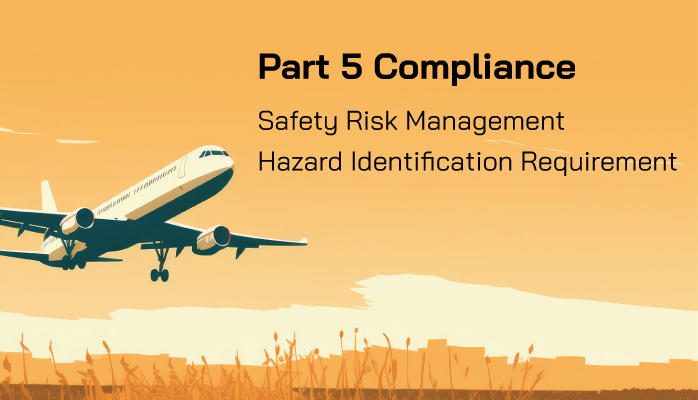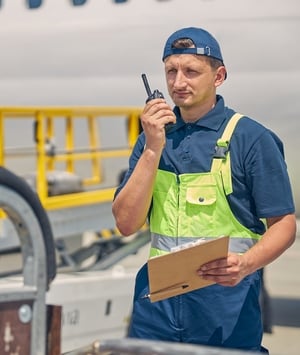FAA’s Safety Risk Management (SRM) Process and Hazard Identification Element

The Federal Aviation Administration’s (FAA) SRM compliance requirement for hazard identification controls every U.S. aviation service provider required to implement formal aviation safety management systems (SMS). These SRM requirements indirectly affect these operators' safety culture and risk management processes whether they like it or not.
Unlike traditional safety programs, formal aviation SMS implementations have requirements for management to participate and provide oversight to ensure the SMS remains operational across the entire organization.
The FAA’s SRM process gets a lot of attention – and for good reason.
Related Articles on Aviation SMS Safety Risk Management (SRM)
- 4 Elements of Safety Risk Management (SRM)
- Most Important Activities in Safety Risk Management (SRM)
- How to Implement SRM Process in Aviation SMS [With Free Checklist]
SRM Processes Revolve Around Operational Risk Profile
Despite the fact that the FAA was a little late in adopting and enforcing ICAO's SMS regulatory requirements, oversight agencies, and operators from many countries around the world look to the FAA for guidance. If you need some quality guidance on implementing an aviation SMS, the FAA's Advisory Circular (AC)120-92B is an excellent resource, even if you are not required to abide by the FAA's 14 CFR Part 5 regulations.
Besides AC 120-92B, ICAO publishes surprisingly very good SMS implementation guidance in the form of their Safety Management Manual (SMM), now in its fourth edition. Regardless of which SMS implementation resources you prefer, they all have the same message. SMS requirements are the same for all aviation service providers; therefore, if you are an airline, your SMS will resemble the SMS of an airport or aviation maintenance provider.
As you implement your SMS, you will develop and document your risk management processes. The Safety Risk Management (SRM) processes will revolve around your operational risk profile. While the SMS structure between different operator types will be the same, the operational risk profile of every operator will be unique, as each operator has:
- different types of operations, from simple to complex;
- unique challenges based on industry-segment type, size, and geographic region.
Due to the various types of operations in the aviation system, these operators may be exposed to not only unique operational hazards but also shared hazards, such as climate and wildlife. Furthermore, operators may have unique business processes that offer them a competitive advantage in the marketplace, such as operating from gravel landing strips. These unique business processes are analyzed and documented thoroughly in your aviation SMS' SRM processes.
FAA Safety Risk Management (SRM) Process
The FAA’s SRM process is based on five components that flow together. The Hazard Identification Element of this process requires you to consider:
- What hazards exist in the operational environment;
- What Human Factors contribute to hazard expression;
- What the limitations are of the systems' hardware, software, and materials; and
- What the limitations are of the SMS implementation's bureaucracy, such as policies, procedures, checklists, etc.
The Hazard Identification element requires you to answer these questions by identifying and listing all hazards. Furthermore,
- Identifying hazards should also carry over (such as via training) into the operational environment; and
- Employees should be aware of and be able to recognize these hazards in their daily activities.
- Employees are cognizant of risk controls and capable of determining whether risk controls are working.
Hazard Identification will naturally arise from the System Description process as you define the scope of the SMS implementation. SRM processes require process owners, subject matter experts, and the safety team to perform risk analysis on each identified hazard. These hazards populate your hazard/risk register.
Related Aviation SMS Hazard Register Articles
- What Is a Hazard Register?
- Tips Tying Corrective Actions and Preventive Actions to Hazard Register
- Winter Fatigue Hazard Register Review - Aviation SMS SRM & SA Example
What Is a Hazard (Two Viewpoints)
There are two commonly accepted opinions about what a hazard is in the operational environment. They are as follows:
- A hazard is a benign thing that has the potential to become dangerous if the hazard is “expressed” (i.e., toxic chemicals, high voltage lines, a mountain, flock of birds); and
- A hazard is a dangerous condition that can lead to (injury, damage, or harmful reductions – in this understanding, point number 1 would be considered a “hazardous source.”)
These viewpoints seem similar, but they actually describe two different phases in the flow of safety events. Point number one refers to root causes. Point number two, which is the FAA’s point of view, is that the hazard occurs near the Dangerous Condition phase – i.e. that a hazard becomes a hazard when it is “expressed.”

The FAA describes a hazard as, “A condition that could foreseeably cause or contribute to an...accident...”.
ICAO accounts for both views within its definition, allowing oversight agencies to adopt whichever concept of hazard that they prefer, “A condition or object with the potential to cause injuries... damage... or reduction...”
If you are an aviation service provider in the USA, it’s important to ensure that “hazards” are treated in your SMS in the FAA’s prescribed definition, and NOT as in point number 1 above. This is very important because we constantly see hazards being understood and treated in the United States as a “benign thing” rather than a “condition.”
Related Aviation Hazard Articles
- Difference Between Hazards, Risks & Control Measures in Aviation SMS
- How to Identify Hazards and Assess Risks in Aviation SMS - With Free Resources
- What Is Proactive Hazard Identification and Risk Management in Aviation SMS
Maintaining and Monitoring Hazard Identification Process
Maintaining a hazard identification process, fortunately, is a natural outcome of sincere aviation SMS implementation. For example, safety management systems with a formal risk management process will do this naturally as they
- Review existing hazards as reported safety issues enter the SMS;
- Evaluate these hazards' existing risk controls for effectiveness; and
- Identify whether new, unidentified hazards relate to current reported safety issues.
Risk management processes, as you treat reported safety issues, can be proactive, such as with safety scenarios or safety cases, or reactive, such as in response to reported safety issues, such as accidents and incidents. Proof of whether your SRM processes exist is demonstrated by:
- An up-to-date hazard risk register that documents all hazards, risks, and control measures; and
- A demonstrable process for identifying new hazards (such as the risk management process for treating reported safety issues and audit findings from the Safety Assurance (SA) monitoring process).
Monitoring Hazard Identification performance is actually inherent in the rest of the SRM and SA processes. Here are some obvious signs of effective hazard identification performance:
- A large percentage of reported safety issues are in the “acceptable” risk range;
- Long-term, steady increase in monthly submitted hazard reports, followed by a leveling off (indicates hazard identification is functioning at full capacity); and
- The growing trend of newly identified hazards decreases over time.
Demonstrating SRM Process and Hazard Identification Compliance
Demonstrating compliance with the Hazard Identification element of the FAA’s SRM process is indicated when:
- Your company has a safety reporting system
- to capture hazards,
- is simple to use, and
- accessible to all personnel;
- Your company has proactively identified all the major hazards in your operating environment;
- Your safety reporting system includes feedback to the reporter of any actions taken (or not taken) and, where appropriate, to the rest of the organization;
- Hazard identification becomes an ongoing process and involves all key personnel and appropriate stakeholders;
- Employees have a strong history of hazard identification training;
- Your company’s operations indicate that you have adopted a definition of hazard that is consistent with the FAA’s definition of a hazard;
- Personnel express confidence and trust in the organization's reporting policy and process;
- The hazards identified are documented and kept available for future reference; and
- The organization uses the results of the investigation of incidents and accidents as a source for hazard identification in your SMS program.
Related Aviation Hazard Identification Articles
- Understanding Role of Hazard Identification Training and Safety Reporting Forms in Aviation SMS
- 4 Tips to Approach Hazard Identification in Aviation SMS
- From Reactive to Proactive Hazard Identification in Aviation SMS
Sources of Hazards for Safety Management Systems

Hazard Identification will arise from three areas of operations:
- System design analysis;
- Task analysis; and
- Safety issue reporting.
The most obvious hazards can be initially identified by analyzing the design of your SMS' relevant systems and reviewing operations. These elements include things like:
- Safety policies;
- Risk management tools;
- Safety management system software;
- Organizational structures (SMS org chart);
- Civil aviation authority (CAA) advisories and mandatory reporting requirements; and
- Documents.
In concert with system analysis, analyzing tasks should also prove to be a good source for hazard identification, including:
- Safety procedures;
- Checklists;
- Duties and responsibilities;
- Aviation safety training; and
- Materials used in an operational environment.
Finally, as new or unidentified hazards arise in reported safety or operational issues, management can expand its list of identified hazards. This will be accomplished in the FAA’s Safety Assurance process where stakeholders continuously monitor the "systems."
What Are Hazard Mechanisms (as Defined by FAA)
We are considering what makes up a hazard as defined by the FAA. In the FAA’s understanding of a hazard, a hazard is comprised of three mechanisms, known as the Hazard Triangle:
- Hazardous sources – a rudimentary element of a hazard such as toxic chemicals, power lines, mountains, etc.
- Initiating mechanism – causal factor(s) that transform hazardous sources into hazardous conditions, such as any number of Human Factors; and
- Target – on who/what the hazardous condition is happening, such as on an aircraft, a person, etc.
It’s important to understand these mechanisms because they will strongly influence the control measures that you use to control the hazard. Your control measures should directly address the mechanisms of a hazard. Cut out the mechanisms and you mitigate the hazard.
Related Articles on Aviation SMS Control Measures
- What Is a Risk Control in Aviation SMS: Meaning, Purpose, Application
- How to Monitor the Effectiveness of Control Measures
- 5 Tips Reviewing Hazards, Risks & Controls in Aviation SMS - With Examples
Training Hazard Identification Ability in SMS Implementations
All employees should receive aviation safety training that includes a hazard identification component. For ICAO-compliant SMS implementations, this training requirement first appears in Phase 2. Employees must become well-versed in hazard identification practices, especially in the areas where they interact with people, machinery, and the environment.
Employees should be versed in:
- The mechanisms of a hazard;
- Hazards in your company;
- What happens when hazards manifest themselves (risk scenarios);
- How to control hazards and determine whether risk controls are working;
- Hazard reporting options in your company; and
- The elements of a Dangerous Condition phase (i.e., Risk Event, Undesirable Consequences, etc.)
It hardly needs to be said that hazard identification training is critical for effective hazard-reporting cultures. When employees aren’t trained on hazard identification, it will severely hinder the effectiveness of the SMS and actually work against SMS implementation efforts. Hazard identification training is responsible for so very much within a performant SMS, including:
- Demonstrating continuous improvement;
- Facilitating risk analysis;
- System monitoring activities;
- Required data acquisition and SMS documentation activities; and
- Analysis of data for proactive and predictive risk management processes.
In short, lack of hazard identification training can render impotent the entire Safety Risk Management and Safety Assurance processes.
If you've come this far, chances are this information was helpful. The good news is we have much more guidance to offer in this free e-book that offers FULL coverage of what you need to know to comply with each element of the FAA's Safety Risk Management process.
Last updated in January 2025.








